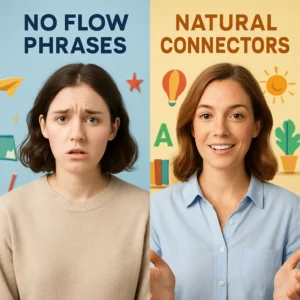Mastering English flow phrases is the secret to speaking naturally and confidently in any conversation. These essential conversation connectors help you transition smoothly between ideas, express yourself clearly, and sound like a native speaker. Whether you’re preparing for business meetings, casual conversations, or academic discussions, understanding how to use flow phrases effectively will transform your English communication skills.
In this comprehensive guide, we’ll explore 15 powerful English flow phrases that will enhance your speaking fluency and help you navigate conversations with confidence. From expressing agreement and disagreement to managing interruptions and clarifying points, these phrases are your key to natural, flowing English conversations.
This video demonstrates authentic English flow phrases from beginner to advanced levels, perfect for practicing pronunciation and conversation flow. Don’t forget to subscribe to our YouTube channel for more practical English conversation lessons!
How to Use This Video for Maximum Learning:
- First viewing: Watch without pausing to get the overall flow of natural conversation
- Second viewing: Pause after each phrase section to practice pronunciation
- Third viewing: Shadow speak along with the dialogue for intonation practice
- Fourth viewing: Focus on specific phrases and their contextual usage

Table of Contents
- Watch the Complete English Flow Phrases Video
- Why English Flow Phrases Matter for ESL Learners
- Essential English Flow Phrases Vocabulary
- Agreement and Acknowledgment Flow Phrases
- Disagreement and Contrast Flow Phrases
- Clarification and Explanation Flow Phrases
- Time and Sequence Flow Phrases
- Opinion and Perspective Flow Phrases
- Conversation Management Flow Phrases
- Advanced Business Flow Phrases
- Key Grammar Patterns for Flow Phrases
- Cultural Tips for Natural Conversation Flow
- Common Mistakes to Avoid
- Practice Exercises and Role-Play Scenarios
- Advanced Flow Phrases for Professional Use
- Free English Flow Phrases Worksheet Download
- Flow Phrases Knowledge Quiz
Why English Flow Phrases Matter for ESL Learners
English flow phrases are more than just conversation fillers; they are the bridge that connects your thoughts and helps you communicate naturally and effectively. Understanding and using these phrases correctly can significantly enhance your speaking fluency and confidence.
Benefits of Mastering Flow Phrases:
Enhanced Fluency:
- Reduces awkward pauses and hesitations in conversation
- Creates smooth transitions between different topics
- Helps maintain natural conversation rhythm
- Allows time to think while speaking
Improved Communication:
- Clarifies your intended meaning and perspective
- Helps listeners follow your train of thought
- Reduces misunderstandings in conversation
- Makes your speech sound more professional
Increased Confidence:
- Provides ready-to-use phrases for any situation
- Helps you sound more like a native speaker
- Reduces anxiety about speaking English
- Gives you tools to manage challenging conversations
Cultural Integration:
- Demonstrates understanding of English conversation norms
- Shows respect for communication patterns
- Helps build rapport with native speakers
- Improves networking and relationship-building abilities
Essential English Flow Phrases Vocabulary
Before diving into the specific flow phrases, let’s review key vocabulary and concepts you’ll encounter when learning to speak more naturally in English.
Core Flow Phrase Categories:
Agreement and Acknowledgment:
- Absolutely: Complete agreement or confirmation
- Definitely: Strong positive agreement
- Exactly: Precise agreement with someone’s point
- That’s right: Confirmation of correctness
Disagreement and Contrast:
- However: Introduces contrasting information
- On the other hand: Presents alternative perspective
- Actually: Corrects or clarifies information
- Nevertheless: Shows contrast despite previous point
Clarification and Explanation:
- In other words: Rephrases for clarity
- What I mean is: Explains your intended meaning
- To clarify: Makes something clearer
- Basically: Simplifies complex information
Essential Conversation Connectors:
Transition Words:
- “Moving on to…”
- “Speaking of which…”
- “That reminds me…”
- “By the way…”
Opinion Markers:
- “In my opinion…”
- “From my perspective…”
- “I believe that…”
- “It seems to me…”
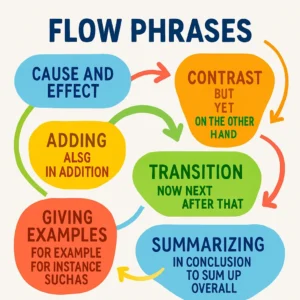
Agreement and Acknowledgment Flow Phrases
These flow phrases help you show agreement, acknowledge others’ points, and build positive conversation dynamics.
🎬 Video Practice Tip: Watch this section at timestamp [0:30-2:15] in our YouTube video above. Focus on the intonation patterns for agreement phrases.
Essential Agreement Phrases:
Strong Agreement:
- “Absolutely!” – Shows complete agreement with enthusiasm
- “Exactly my thoughts!” – Indicates perfect alignment of ideas
- “You’re absolutely right!” – Confirms someone’s correctness
- “I couldn’t agree more!” – Expresses maximum agreement
Moderate Agreement:
- “That’s a good point.” – Acknowledges validity of someone’s argument
- “I see what you mean.” – Shows understanding of their perspective
- “You have a point there.” – Recognizes merit in their statement
- “That makes sense.” – Indicates logical understanding
Conditional Agreement:
- “I agree to some extent.” – Shows partial agreement
- “You’re right about that, but…” – Agrees while introducing contrast
- “I can see your point, however…” – Acknowledges while disagreeing
- “That’s true in most cases.” – Shows general agreement with exceptions
Grammar Focus: Agreement Patterns
Emphatic Agreement Structure:
- “You’re absolutely [adjective]” (You’re absolutely correct)
- “That’s exactly [what/how/why]” (That’s exactly what I was thinking)
- “I completely [verb]” (I completely understand)

Disagreement and Contrast Flow Phrases
Learning to disagree politely and introduce contrasting ideas is crucial for natural English conversation flow.
🎬 Video Practice Tip: Watch this section at timestamp [2:16-4:00] in our YouTube video above. Notice how tone remains respectful while expressing disagreement.
Polite Disagreement Phrases:
Soft Disagreement:
- “I’m not sure I agree with that.” – Gentle disagreement expression
- “I see it differently.” – Shows alternative perspective politely
- “That’s one way to look at it, but…” – Acknowledges their view while contrasting
- “I have a different opinion on that.” – States disagreement respectfully
Direct but Polite Disagreement:
- “Actually, I think…” – Corrects information politely
- “I’m afraid I have to disagree.” – Formal disagreement expression
- “With respect, I believe…” – Shows respect while disagreeing
- “I understand your point, but…” – Acknowledges before contrasting
Contrast and Alternative Ideas:
- “However, we should consider…” – Introduces contrasting information
- “On the other hand…” – Presents alternative perspective
- “Nevertheless…” – Shows contrast despite previous point
- “In contrast…” – Directly compares different viewpoints
Grammar Focus: Contrast Patterns
Contrasting Conjunctions:
- “Although [statement], [contrasting statement]”
- “While [point A], [point B]”
- “Despite [fact], [contrasting fact]”
Clarification and Explanation Flow Phrases
These phrases help you clarify your meaning, ask for clarification, and ensure mutual understanding in conversations.
🎬 Video Practice Tip: Watch this section at timestamp [4:01-5:45] in our YouTube video above. Pay attention to questioning intonation for clarification requests.
Clarifying Your Own Meaning:
Rephrasing for Clarity:
- “In other words…” – Restates in simpler terms
- “What I mean is…” – Explains intended meaning clearly
- “To put it simply…” – Simplifies complex information
- “Let me clarify…” – Introduces clearer explanation
Adding Detail:
- “Specifically…” – Provides specific examples or details
- “For example…” – Introduces illustrative examples
- “In particular…” – Highlights specific aspects
- “More precisely…” – Gives exact information
Asking for Clarification:
Polite Clarification Requests:
- “Could you clarify what you mean by…?” – Polite request for explanation
- “I’m not sure I follow.” – Indicates confusion politely
- “Could you elaborate on that?” – Asks for more detail
- “What exactly do you mean?” – Seeks precise meaning
Checking Understanding:
- “Do you mean…?” – Confirms interpretation
- “Are you saying that…?” – Verifies understanding
- “If I understand correctly…” – Checks comprehension
- “So what you’re telling me is…” – Summarizes for confirmation
Grammar Focus: Clarification Patterns
Question Forms for Clarification:
- “Could you [verb] + [question word]” (Could you explain how…)
- “I’m not sure [question word]” (I’m not sure what you mean)
- “Do you mean [statement]?” (Do you mean we should wait?)

Time and Sequence Flow Phrases
These phrases help you organize information chronologically and guide listeners through sequences of events or ideas.
🎬 Video Practice Tip: Watch this section at timestamp [5:46-7:30] in our YouTube video above. Notice how these phrases create clear story structure.
Sequential Organization:
Beginning Sequences:
- “First of all…” – Introduces the initial point
- “To begin with…” – Starts a series of points
- “Initially…” – Describes the starting situation
- “At first…” – Shows original state or opinion
Continuing Sequences:
- “Then…” – Shows next step in sequence
- “After that…” – Indicates following action
- “Subsequently…” – Formal way to show what follows
- “Next…” – Simple transition to following point
Concluding Sequences:
- “Finally…” – Introduces the last point
- “In the end…” – Shows ultimate result
- “Ultimately…” – Indicates final outcome
- “To conclude…” – Formal ending phrase
Time Transitions:
Immediate Time References:
- “Right now…” – Refers to current moment
- “At this moment…” – Emphasizes present time
- “Currently…” – Shows present state
- “These days…” – Refers to recent period
Past and Future References:
- “Previously…” – Refers to earlier time
- “Looking ahead…” – Focuses on future
- “From now on…” – Indicates future change
- “Moving forward…” – Shows future direction
Grammar Focus: Time and Sequence Patterns
Temporal Adverbs:
- “[Time phrase] + [main clause]” (Initially, we thought…)
- “[Main clause] + [time phrase]” (We decided, ultimately,…)
- “[Time connector] + [clause]” (After that, everyone agreed)

Opinion and Perspective Flow Phrases
These phrases help you express personal viewpoints, introduce opinions, and show different perspectives in conversation.
🎬 Video Practice Tip: Watch this section at timestamp [7:31-9:15] in our YouTube video above. Focus on how opinion markers set up personal statements.
Expressing Personal Opinions:
Strong Opinion Markers:
- “In my opinion…” – Classic opinion introduction
- “From my perspective…” – Shows personal viewpoint
- “I strongly believe that…” – Expresses firm conviction
- “I’m convinced that…” – Shows certainty in opinion
Moderate Opinion Markers:
- “I think…” – Simple opinion expression
- “It seems to me…” – Suggests personal interpretation
- “I have a feeling that…” – Expresses intuitive opinion
- “I tend to think…” – Shows general inclination
Tentative Opinion Markers:
- “I might be wrong, but…” – Shows uncertainty while offering opinion
- “I could be mistaken, however…” – Humble opinion introduction
- “This is just my view, but…” – Modest opinion statement
- “I may be off base, yet…” – Uncertain opinion marker
Introducing Others’ Perspectives:
Reporting Others’ Views:
- “According to…” – Cites someone’s opinion
- “From their standpoint…” – Shows others’ perspective
- “They argue that…” – Reports others’ arguments
- “Their position is…” – States others’ stance
Comparing Perspectives:
- “Some people think…, while others believe…” – Contrasts viewpoints
- “One school of thought suggests…” – Introduces academic perspective
- “Critics argue that…” – Presents opposing views
- “Supporters claim that…” – Shows positive perspective
Grammar Focus: Opinion Expression Patterns
Opinion Clause Structures:
- “I [opinion verb] + that + [clause]” (I believe that education is important)
- “From my [perspective noun], [statement]” (From my viewpoint, this works)
- “It seems + [adjective] + that + [clause]” (It seems likely that…)

Conversation Management Flow Phrases
These essential phrases help you control conversation flow, manage interruptions, and guide discussions effectively.
🎬 Video Practice Tip: Watch this section at timestamp [9:16-11:00] in our YouTube video above. Notice how these phrases maintain conversation control.
Changing Topics:
Smooth Topic Transitions:
- “Speaking of which…” – Natural topic connection
- “That reminds me…” – Links to related topic
- “By the way…” – Casual topic change
- “Before I forget…” – Urgent topic introduction
Direct Topic Changes:
- “Moving on to…” – Clear topic transition
- “Let’s talk about…” – Direct topic shift
- “I’d like to discuss…” – Formal topic introduction
- “Another thing I wanted to mention…” – Additional topic
Managing Interruptions:
Polite Interruption:
- “Sorry to interrupt, but…” – Polite interruption phrase
- “If I may…” – Formal interruption request
- “Excuse me…” – Standard interruption opener
- “Can I just say…” – Gentle interruption
Returning to Previous Topics:
- “As I was saying…” – Returns to interrupted point
- “Going back to…” – Revisits earlier topic
- “Where was I?” – Asks for topic reminder
- “To continue…” – Resumes previous discussion
Buying Time to Think:
Thinking Phrases:
- “Let me think about that…” – Requests thinking time
- “That’s a good question…” – Acknowledges while thinking
- “Well…” – Simple time-buying phrase
- “How should I put this…” – Prepares thoughtful response
Organizing Thoughts:
- “There are several points here…” – Structures complex response
- “Let me break this down…” – Organizes information
- “The main issue is…” – Identifies central point
- “To summarize…” – Concludes main points
Grammar Focus: Conversation Management Patterns
Interruption Structures:
- “[Apology] + [interruption phrase] + [point]” (Sorry to interrupt, but I disagree)
- “[Request phrase] + [statement]” (If I may, I’d like to add…)
- “[Transition phrase] + [new topic]” (Speaking of which, did you hear…)
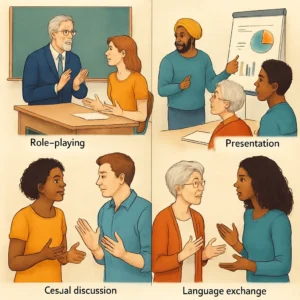
Advanced Business Flow Phrases
For professional settings, these sophisticated flow phrases demonstrate executive communication skills and business acumen.
🎬 Video Practice Tip: Watch this section at timestamp [11:01-12:45] in our YouTube video above. Note the formal tone and professional delivery.
Professional Agreement and Support:
Executive Agreement:
- “I fully endorse that approach.” – Strong professional support
- “That aligns with our strategic goals.” – Business-focused agreement
- “I’m on board with that initiative.” – Modern business agreement
- “That’s consistent with our objectives.” – Formal business alignment
Qualified Professional Agreement:
- “I support that in principle, however…” – Conditional business support
- “While I see the merit, we should consider…” – Balanced professional view
- “That’s a solid foundation, but…” – Constructive professional feedback
- “I appreciate the logic, yet…” – Respectful professional disagreement
Business Clarification and Analysis:
Strategic Clarification:
- “To ensure we’re aligned…” – Business alignment check
- “For clarity on our objectives…” – Professional goal clarification
- “To establish clear parameters…” – Business boundary setting
- “Let me outline the key considerations…” – Executive analysis
Data and Evidence References:
- “The data suggests…” – Evidence-based statement
- “Our research indicates…” – Professional research reference
- “The metrics show…” – Data-driven observation
- “Based on our analysis…” – Analytical conclusion
Executive Opinion Expression:
Leadership Perspective:
- “From a strategic standpoint…” – Executive viewpoint
- “Considering our market position…” – Business context opinion
- “Given our competitive landscape…” – Market-aware perspective
- “From an operational perspective…” – Functional viewpoint
Recommendation Language:
- “I recommend we proceed with…” – Executive recommendation
- “My suggestion would be to…” – Professional advice
- “The optimal approach is…” – Best practice recommendation
- “I propose we consider…” – Strategic proposal
Grammar Focus: Business Communication Patterns
Professional Structures:
- “From a [business area] perspective, [statement]” (From a financial perspective, this works)
- “Given [business context], [recommendation]” (Given our timeline, I suggest…)
- “Based on [evidence/data], [conclusion]” (Based on market research, we should…)

Key Grammar Patterns for Flow Phrases
Understanding the grammatical structures behind flow phrases helps you use them correctly and create your own natural-sounding transitions.
Conditional and Contrast Patterns:
Conditional Structures:
- “If [condition], then [result]” – Logical flow pattern
- “Unless [condition], [consequence]” – Negative conditional
- “Provided that [condition], [outcome]” – Formal conditional
- “In case [situation], [response]” – Preparatory conditional
Contrast Conjunctions:
- “Although [statement A], [statement B]” – Concessive contrast
- “While [point 1], [point 2]” – Temporal or contrast connection
- “Despite [fact], [contrasting fact]” – Strong contrast marker
- “Nevertheless, [contrasting point]” – Formal contrast transition
Cause and Effect Patterns:
Causation Structures:
- “Because [cause], [effect]” – Direct causation
- “Due to [reason], [result]” – Formal causation
- “As a result of [cause], [effect]” – Consequential relationship
- “Therefore, [conclusion]” – Logical conclusion marker
Result and Consequence:
- “Consequently, [outcome]” – Formal result marker
- “This leads to [result]” – Direct consequence
- “The outcome is [result]” – Clear result statement
- “Hence, [conclusion]” – Formal conclusion marker
Modal and Probability Patterns:
Certainty and Probability:
- “It’s likely that [prediction]” – Probability expression
- “There’s a chance that [possibility]” – Possibility marker
- “It’s certain that [fact]” – Certainty expression
- “Probably [statement]” – Informal probability
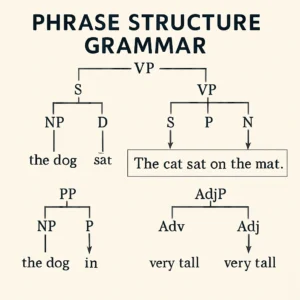
Cultural Tips for Natural Conversation Flow
Understanding cultural nuances helps you use flow phrases appropriately across different English-speaking environments and social contexts.
American English Flow Patterns:
Direct Communication Style:
- Americans often prefer clear, direct transitions
- “Bottom line…” is commonly used in business
- “Let me be honest…” shows appreciated directness
- Quick topic changes are generally acceptable
Informal Flow Preferences:
- Casual connectors like “So…” and “Anyway…” are very common
- “You know what?” is frequently used to introduce points
- Americans appreciate efficient conversation flow
- Interruptions are often acceptable in casual settings
British English Flow Patterns:
Polite Indirectness:
- “I don’t suppose…” softens disagreement
- “Perhaps we might consider…” shows politeness
- “If I may…” is preferred for interruptions
- More formal flow phrases in business settings
Understatement Culture:
- “Rather” is commonly used for emphasis
- “Quite” modifies opinions appropriately
- “I’m afraid…” softens negative information
- Hedging phrases show cultural awareness
International Business Flow:
Cross-Cultural Considerations:
- Slower pace allows for translation processing
- Clear topic markers help non-native speakers
- Avoiding idiomatic flow phrases in international meetings
- Checking understanding more frequently
Inclusive Communication:
- “As [name] mentioned…” includes everyone
- “Building on that idea…” shows collaboration
- “Let’s make sure everyone’s on the same page…” ensures understanding
- Pausing for questions shows respect
Social Context Adaptations:
Formal vs. Informal Settings:
- Academic: “Furthermore…” and “Moreover…”
- Business: “Additionally…” and “In conclusion…”
- Casual: “Plus…” and “Anyway…”
- Social: “Oh, and…” and “By the way…”
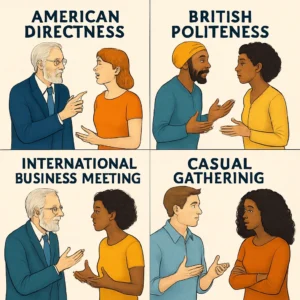
Common Mistakes to Avoid
Learning what NOT to do with flow phrases is just as important as learning correct usage. Here are the most frequent errors ESL learners make.
Overuse and Repetition Mistakes:
Repetitive Flow Phrase Use:
- Wrong: “So, I went to the store. So, I bought some milk. So, I came home.”
- Right: “I went to the store, bought some milk, and then came home.”
- Tip: Vary your connectors to avoid monotony
Excessive Formal Phrases in Casual Settings:
- Wrong: “Furthermore, I would like to express that this pizza is delicious.”
- Right: “Also, this pizza is really good!”
- Tip: Match formality level to the situation
Timing and Placement Errors:
Incorrect Flow Phrase Positioning:
- Wrong: “I think, however, that we should leave.”
- Right: “I think we should leave. However, we could stay longer.”
- Tip: Place contrast phrases at the beginning of new sentences
Inappropriate Interruption Timing:
- Wrong: Interrupting immediately without listening
- Right: Waiting for a natural pause before using “If I may…”
- Tip: Read the conversation rhythm before interrupting
Meaning and Context Mistakes:
Wrong Flow Phrase Choice:
- Wrong: “In conclusion…” (in the middle of a conversation)
- Right: “To sum up…” or “So far…”
- Tip: “In conclusion” is for endings only
Mismatched Tone and Content:
- Wrong: “I’m afraid to say this movie is amazing!”
- Right: “I have to say this movie is amazing!”
- Tip: “I’m afraid” introduces negative information
Grammar Structure Mistakes:
Incomplete Contrast Structures:
- Wrong: “Although I like coffee.” (incomplete sentence)
- Right: “Although I like coffee, I prefer tea.”
- Tip: “Although” requires two complete clauses
Incorrect Modal Usage:
- Wrong: “I definitely might go.” (contradictory certainty levels)
- Right: “I might go” or “I’ll definitely go.”
- Tip: Don’t mix certainty levels in the same phrase
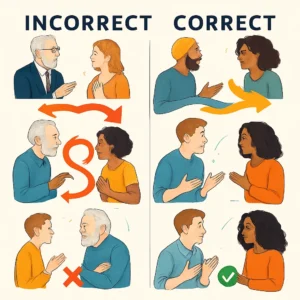
Practice Exercises and Role-Play Scenarios
Exercise 1: Flow Phrase Integration
Scenario: You’re in a team meeting discussing a new project timeline.
Your Role: Project coordinator who needs to manage different opinions and keep the discussion flowing smoothly.
Practice Points:
- Use agreement phrases when team members make good suggestions
- Employ polite disagreement when you have concerns about feasibility
- Utilize clarification phrases when requirements are unclear
- Apply time sequence phrases when outlining project phases
Exercise 2: Opinion Expression Practice
Scenario: Casual conversation with friends about choosing a vacation destination.
Your Role: Friend who has strong preferences but wants to be diplomatic.
Practice Points:
- Express your opinion using appropriate markers
- Show interest in others’ perspectives
- Use contrast phrases when you disagree with suggestions
- Employ topic management phrases to explore different options
Exercise 3: Professional Presentation Flow
Scenario: Giving a presentation to senior management about quarterly results.
Your Role: Department manager presenting both positive and concerning data.
Practice Points:
- Use professional agreement phrases when acknowledging executive questions
- Employ business-appropriate clarification when explaining complex data
- Utilize advanced transition phrases between presentation sections
- Apply executive-level opinion markers when making recommendations
Video-Based Practice Exercises
Shadow Speaking with the Video:
- Play the video at 0.75x speed for your first shadow speaking attempts
- Focus on one phrase category at a time – don’t try to shadow everything at once
- Pause between sections to practice your own examples using the phrases
- Record yourself using the phrases in context and compare with natural examples
Real-Life Application Challenges:
Daily Practice Goals:
- Morning: Use 3 agreement phrases in conversations
- Afternoon: Practice 2 clarification phrases when asking questions
- Evening: Employ 2 opinion markers when discussing your day
Weekly Challenge Progression:
- Week 1: Master basic agreement and disagreement phrases
- Week 2: Focus on clarification and explanation connectors
- Week 3: Practice advanced business and professional flow phrases
- Week 4: Integrate all phrases naturally in extended conversations
Advanced Flow Phrases for Professional Use
For those seeking to elevate their professional communication, these sophisticated flow phrases demonstrate executive-level English proficiency.
Strategic Communication Phrases:
Vision and Direction:
- “From a strategic standpoint…” – Executive perspective introduction
- “Considering our long-term objectives…” – Strategic thinking demonstration
- “With our market position in mind…” – Business-aware perspective
- “Given our competitive advantage…” – Strategic analysis marker
Executive Decision-Making:
- “After careful consideration…” – Thoughtful decision introduction
- “Weighing all factors…” – Comprehensive analysis indicator
- “Taking everything into account…” – Holistic evaluation phrase
- “Based on thorough analysis…” – Data-driven decision marker
Diplomatic Professional Language:
Constructive Challenge:
- “I’d like to offer a different perspective…” – Diplomatic disagreement
- “Have we considered the implications of…” – Thoughtful questioning
- “Perhaps we should explore…” – Diplomatic suggestion
- “It might be worth examining…” – Gentle alternative proposal
Collaborative Leadership:
- “Building on that excellent point…” – Inclusive leadership
- “To expand on [name]’s insight…” – Collaborative development
- “That aligns perfectly with…” – Harmony demonstration
- “Let’s synthesize these ideas…” – Integration leadership
Crisis and Problem-Solving Flow:
Solution-Oriented Language:
- “Despite these challenges…” – Problem acknowledgment with forward focus
- “While this presents difficulties…” – Balanced problem assessment
- “Notwithstanding these obstacles…” – Formal challenge acknowledgment
- “Even with these constraints…” – Realistic optimism expression
Innovation and Change:
- “This opens up possibilities for…” – Innovation encouragement
- “We have an opportunity to…” – Positive change framing
- “This could be a catalyst for…” – Change leadership language
- “Let’s leverage this to…” – Strategic opportunity identification

Free English Flow Phrases Worksheet Download
📋 Customized Exercise Types:
- Flow phrase matching (15 essential phrases with definitions)
- Conversation completion (gaps created from actual dialogue examples)
- Scenario practice (agreement, disagreement, clarification situations)
- Video comprehension (questions linked to YouTube timestamps)
- Grammar focus (sentence patterns for natural flow)
- Cultural awareness (appropriate usage in different contexts)
Download Your Free Worksheet
🎯 Immediate Download Features:
- PDF format for easy printing and offline use
- Professional layout with answer key included
- Mobile-friendly design for on-the-go practice
- Copyright cleared for personal educational use
Flow Phrases Knowledge Quiz
Test your understanding of English flow phrases with this quick quiz:
Question 1: Which phrase is best for expressing strong agreement?
a) I’m not sure about that
b) Absolutely, you’re right!
c) That’s one way to look at it
d) I see what you mean
Question 2: When should you use “However” in conversation?
a) To agree enthusiastically
b) To introduce contrasting information
c) To ask for clarification
d) To end a conversation
Question 3: Which phrase is most appropriate for polite interruption in a business meeting?
a) Wait, stop talking!
b) If I may interrupt…
c) Listen to me now
d) Hey, I have something to say
Question 4: “In other words…” is best used for:
a) Expressing disagreement
b) Changing topics completely
c) Rephrasing for clarity
d) Ending a conversation
Question 5: Which phrase shows the most professional level of disagreement?
a) That’s wrong
b) I don’t like that idea
c) You’re completely off base
d) I’d like to offer a different perspective
Quiz Answers:
- b) Absolutely, you’re right! – This shows enthusiastic, complete agreement
- b) To introduce contrasting information – “However” is a contrast connector
- b) If I may interrupt… – This is polite and professional for business settings
- c) Rephrasing for clarity – “In other words” introduces clearer explanations
- d) I’d like to offer a different perspective – This is diplomatic and professional
How did you score?
- 5/5: Excellent! You’re ready for confident natural conversation flow
- 3-4/5: Good! Review the specific phrase categories you missed
- 1-2/5: Keep practicing! Focus on the essential phrases and their contexts
- 0/5: Start with the basic agreement and disagreement phrases first
Conclusion: Master English Flow Phrases for Natural Conversation
Mastering English flow phrases is an essential skill that will transform your conversations from hesitant exchanges into confident, natural interactions. The 15 essential flow phrase categories we’ve explored cover every major conversation situation you’ll encounter, and our accompanying YouTube video provides the perfect pronunciation and intonation guide for these real-world applications.
🎥 Don’t forget to watch our complete flow phrases video above and subscribe to our YouTube channel for more practical English conversation lessons!
The 15 Essential Flow Phrase Categories You’ve Mastered:
- Agreement and Acknowledgment with natural enthusiasm and support
- Disagreement and Contrast with polite and respectful language
- Clarification and Explanation with clear and helpful communication
- Time and Sequence with logical organization and structure
- Opinion and Perspective with confident personal expression
- Conversation Management with smooth topic control and transitions
Key Takeaways for Flow Phrase Success:
Natural Integration: Focus on using flow phrases as bridges between your ideas, not as forced additions to every sentence.
Context Awareness: Understanding when to use formal versus informal flow phrases will help you communicate appropriately in different environments.
Cultural Sensitivity: Adapting your flow phrase usage to American directness, British politeness, or international business settings shows sophisticated communication skills.
Practice Consistency: Regular use of these phrases in daily conversations will make them feel natural and automatic.
Your Next Steps:
- Watch the Video: Start by watching our complete flow phrases video above for pronunciation guidance
- Practice Daily: Use 3-5 different flow phrases in your conversations each day
- Build Gradually: Master basic agreement and disagreement phrases before moving to advanced business language
- Record Yourself: Practice the phrases aloud and record yourself to improve pronunciation
- Apply in Context: Use the role-play scenarios to practice flow phrases in realistic situations
🔔 Subscribe to our YouTube channel for weekly English conversation practice videos!
📝 Download our free practice worksheet above and take the knowledge quiz to test your flow phrase skills.
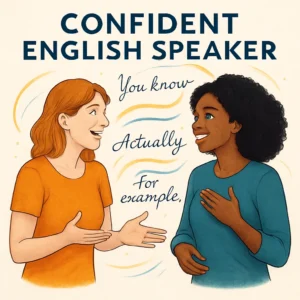
Remember, effective conversation flow isn’t about using every phrase you know—it’s about choosing the right connector at the right moment to help your ideas flow naturally and keep your listeners engaged. With these authentic flow phrases and our video guide, you’re well-equipped to handle any conversation situation with confidence and natural English rhythm.
🎬 Watch More English Conversation Videos: Subscribe to our YouTube channel for practical English lessons including business conversations, travel English, and daily conversation skills.
Recommended Next Reading: 8 Advanced English Conversations for Real-Life Scenarios – Continue building your conversation skills with our comprehensive guide to advanced English dialogues.
👍 If this article helped you, please like, share, and subscribe for more English learning content!
Business enquiries: support@phrasecamp.com
🔷Facebook page: https://www.facebook.com/phrasecamp
All material, information and videos are owned by PhraseCamp © #phrasecamp #englishphrasecamp #englishspeaking #englishfluency
